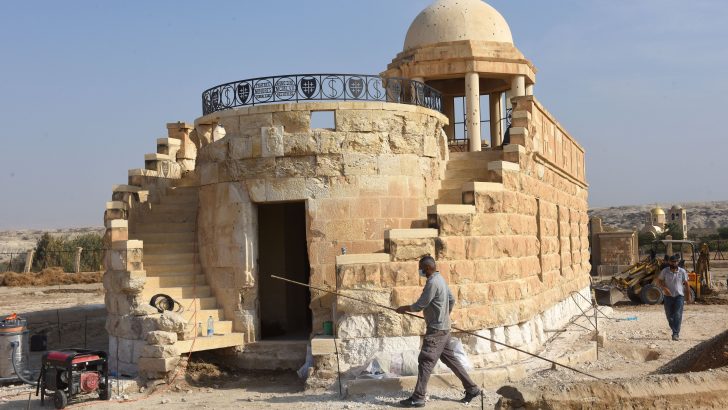What was once a closed military zone has now been opened to pilgrims, writes Michael Kelly
One of the highlights of any pilgrimage to the Holy Land now is a visit to the Qasr al-Yahud site in the West Bank where Jesus was baptised in the River Jordan. I first visited the site in 2007, but back then needed a military escort to ensure that I didn’t stand on any of the landmines that then littered the site. At the weekend, Mass was celebrated there in the Church of St John the Baptism for the first time in 54 years to mark the Feast of the Baptism of the Lord.
After all this time, we have come back. This gives us hope for peace. For us, this is a sign not to lose hope, not to lose hope for peace”
The almost 100-year-old church and monastery were vacated in 1967 at the outbreak of the Six-Day War between Israel and some of its Arab neighbours, including Jordan, just across the River Jordan. After Israel won control of the area from Jordan, the area was laid with land mines by both the Israeli army and Palestinian gunmen who battled in the area in the 1960s and 1970s. It became for many years a fenced military zone, off limits to pilgrims.
The round
Today, the round, second-floor open-air chapel, with its two stairways curving around either side, is still riddled with bullet holes, as are the rooms in the small monastery underneath.
Fr Ibrahim Faltas, chancellor of the Franciscan Custody of the Holy Land, which cares for holy sites said the Franciscans first starting coming to this place in 1641 and began purchasing land in the area in early 1920 to build churches. In 1933, they built a chapel, which is now located on the edge of the river, and in 1935 built a larger St John the Baptist Church, which was destroyed in an earthquake in 1956, and the existing chapel was built in its place.
Fr Faltas
“After all this time, we have come back. This gives us hope for peace. For us, this is a sign not to lose hope, not to lose hope for peace,” Fr Faltas said.
Clearing the area of land mines and making it possible for pilgrims to return has been a long process, with organised groups of pilgrims first allowed to come to the banks of the river in 1994 on the Epiphany and Easter holidays following the signing of the peace treaty with Jordan. A baptismal site was opened on the water’s edge in 2011 for all visitors, who had to walk down a dirt road to the river, with fences and warning signs on either side admonishing them not to veer off the path because of land mines.
The Israeli Ministry of Tourism administered the accessible area near the river as a national park”
Jordan completed demining its eastern bank of the river by 1999. There, Bethany Beyond the Jordan is recognised as a UNESCO World Heritage Site, “believed to be the location where Jesus of Nazareth was baptised by John the Baptist”.
On the West Bank – part of the Palestinian territories which is occupied by Israel – the St John the Baptist Chapel, along with chapels and monasteries belonging to other Christian traditions, remained off limits behind the fences, in the middle of the mine fields. The Israeli Ministry of Tourism administered the accessible area near the river as a national park.
In 2016, Israel began clearing the area with the help of the British HALO Trust, and finally in October the Franciscan Custody of the Holy Land and Christian churches were able to take possession of their properties.
Promised land
The Qasr Al-Yahud site is also revered by Jews as the crossing place along the River Jordan of the biblical Israelites into the ‘promised land’ after having wandered the desert for 40 years.
Pointing out the layout of the area on maps, Leonardo DiMarco – a civil engineer and the director of the technical office of the custody – noted that the chapel is located in the middle of two paths that form a cross and lead to the river. He said the Franciscans were in discussions with the Israeli army to retain the original design.
There are plans to rehabilitate the compound’s walled garden, which over the years has been overtaken by the desert sands, and to build a number of smaller chapels inside the garden to allow for private group and solitary contemplation and prayers for pilgrims, said Mr DiMarco.
“The idea is that pilgrims can come here in preparation to go down to the river,” Mr DiMarco said.
He said he expects the restoration work to be completed by next year and, once travel is permitted again, the site will be open for pilgrimages.
Something special
“It is something special, the way the custody found the place is exactly in the same condition it was after so many years. Everything was left the same, the furniture, small objects, were found in the same place they were left in 1967 when the friars had to leave in a hurry,” he said. He said the bullet holes would not be repaired, but would be kept as a reminder of the war.
“This is the past history of the place, you can’t cancel those things. The door is full of bullet holes, the inside wooden doors. This will be part of the experience of the pilgrims. The place itself is telling something important,” said Mr DiMarco. “It is important; this is a religious place, but not only. It is also a place which was in the middle of a fight.”
Additional reporting by Judith Sudilovsky at Qasr al-Yahud.


 Michael Kelly
Michael Kelly A Palestinian works on the Franciscan Chapel of St John the
Baptist at Qasr al-Yahud. Photo: CNS/Debbie Hill
A Palestinian works on the Franciscan Chapel of St John the
Baptist at Qasr al-Yahud. Photo: CNS/Debbie Hill 